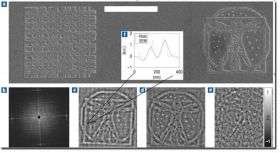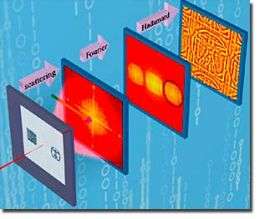Improving our ability to peek inside molecules

(PhysOrg.com) -- It's not easy to see a single molecule inside a living cell. Nevertheless, researchers at Lawrence Livermore National Laboratory are helping to develop a new technique that will enable them to create detailed high-resolution images, giving scientists an unprecedented look at the atomic structure of cellular molecules.
The LLNL team is collaborating with scientists across the country and in Germany and Sweden to utilize high-energy X-ray beams, combined with complex algorithms, to overcome difficulties in current technology.

The work began more than five years ago as a Laboratory Directed Research and Development (LDRD) project, headed by Stefano Marchesini. He has since transferred to Lawrence Berkeley Lab (LBNL), leaving the project in the hands of Stefan Hau-Riege, a materials science physicist at LLNL.
For now, the Advanced Light Source at LBNL and the FLASH facility in Hamburg, Germany, are being used to provide the X-ray beams. But a new facility under construction at Stanford University, the Linac Coherent Light Source (LCLS), will provide additional capabilities and greater imaging accuracy when it comes on line next year.
Another light source being built in Hamburg will be used as well. When completed in late 2013, the X-ray Free Electron Laser (XFEL) will be the world's longest artificial light source.
Using high-energy, extremely short-pulse - less than 100 femtoseconds, or one quadrillionth of a second - X-ray beams to examine nanoscale objects is not a new concept. The difficulty lies with the algorithms to convert the resulting patterns into usable images.
One method to increase the signal and resolution of the image is to include a second item with known features during the laser imaging. Known as a "reference object," it gives the researchers additional information with which to process the imaging data.
What is new is to use a very special reference object called a "uniformly redundant array" (URA). In this case, a combination of complex formulas known as a "Fourier Transform" and a "Hadamard Transform" are utilized to convert the data into an image that represents the object being examined. Hadamard transforms are commonly used in signal processing and data algorithms, including those used in photo and video compression.
According to Hau-Riege, "The resolution we achieved is among the best ever reported for holography of a micrometer-sized object, and we believe that it will improve in the future with the development of nano-arrays for Fourier Transform Holography at LCLS."
Details of the study appear in the August 1 edition of the journal Nature Photonics: www.nature.com/nphoton/journal … photon.2008.154.html
Source: Lawrence Livermore National Laboratory





















